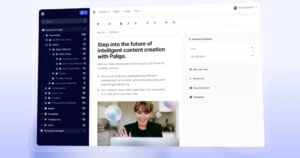- Home
- Blog
- Technical writing
- Distinguishing between CMS, CCMS and when to add a CDP
Distinguishing between CMS, CCMS and when to add a CDP
Share

Summary of presentation by Andrew Owen at TCUK conference 2023
This week, Paligo was represented at the TCUK conference by Solutions Engineer, Andrew Owen, who gave a talk about understanding the differences between CMS, CCMS, and related solutions.
TCUK (Technical Communication UK) is a yearly gathering organized by the ISTC, which promotes scientific and technical communication. This annual conference is intended for people who work in the field of creating, editing, illustrating, distributing, and publishing technical material.
Andrew Owen has worked in several positions, from a technical writer producing software documentation to a developer advocate devising technical solutions, culminating in his present role at Paligo as a solutions engineer. Because of his extensive background in documentation and communication in a multitude of companies producing a wide range of products and services, he is in a prime position to share knowledge about content solutions and content delivery.
At this year’s conference, Andrew highlighted the distinctions between a CMS (headless or otherwise), a CCMS, and a content delivery platform (CDP). He also spoke about the importance of considering which system is most suitable for a company’s particular requirements. People often inquire about the distinctions between these systems, so this is a concise summary for those who couldn’t make it.
Introduction to CMS
You’ve probably heard of WordPress. It’s the most popular web content management system and it’s used by around 40% of the top 10 million websites. Other popular CMSes are Drupal and Joomla. One reason for the popularity of all three solutions is that they’re open source software. The companies behind them provide hosting and other services, but you can take the software and run it on your own server without paying a licensing fee. But then you also have to provide your own server infrastructure and IT support.
Typical Web CMS features include:
Typical Web CMS features include:
• Collaboration
• Document management
• Graphical content editing
• Localization
• Presentation templates
• Role-based access control
• Versioning
• Workflows
Besides the low cost, other advantages are ease of use and good support for search engine optimization (SEO). The disadvantages include:
• Cost of maintenance
• Cost of scaling
• Latency
• Security
Security in particular can be a huge headache. Because WordPress is the most popular CMS on the internet, it’s also the most targeted by malicious actors. Wordfence reported in 2020 that there were more than 2,800 attacks per second targeting WordPress.
How a headless CMS differs from a traditional CMS
With a Web CMS, content editing and delivery is through the browser. A headless CMS separates the presentation (head) from the content (body). Where a web CMS may rely on many server-based applications such as a database to deliver content, typically a headless CMS delivers web content as a static site. This means that all that is required to deliver the content is a web server such as Apache or IIS. The content itself is stored in a code repository (usually Git) and may be hosted on a commercial Git instance such as GitHub.
Text content is written in a mixture of Markdown (a very simple markup language popular with developers) and HTML. The source content is transformed into a website by a static site generator (or SSG) such as Next.js. The content is often hosted by a dedicated hosting platform such as Vercel. Graphical editing may be available using third-party applications such as TinaCMS that interact with the Git repository.
The advantages of a headless CMS over a web CMS for web content include scalability, low latency and security inherent with static sites. But a headless CMS can also deliver content through an API to other “heads” such as a mobile app. The main disadvantage over a web CMS is that they are harder to use.
To further complicate matters, there are now a number of documentation solutions that appear to be a web CMS on the surface, but are actually packaged headless CMSes where the various components are delivered by a single provider. There are open-source and commercial offerings. In some of the latter cases, vendors may not tell you they are selling you an SSG-based solution. But if you are editing content in Markdown, then that’s typically the case.
In other words, headless addresses the shortcomings of web CMS. But thing to consider is the sheer number of combinations of solutions in existence that can make it nigh on impossible to choose which solution to go with. My own personal website uses a headless CMS. I set it up in 2022 with the Hugo static site generator (because it was the fastest available at the time), and the Forestry.io web interface for managing content. Hugo has since fallen out of favor and Forestry.io has been discontinued, which meant I had to migrate the web interface over to the successor product. Businesses who went for the same solution as me found themselves with an unplanned-for migration, so that’s also something to be aware of. It’s also worth noting that while Markdown is very easy to use, it’s also very basic. For example, if you want to create anything other than simple tables, you’ll find yourself having to write HTML.
Introduction to CCMS (Component Content Management Systems)
The most important factor to note when thinking about CCMS is that it is distinct from web CMSes, though many people often mistake the two. The first ‘C’ in a CCMS stands for ‘Component,’ because content in a CCMS is made up of reusable components. These components can be as small as a single word contained in a variable and as large as a publication.
How a CCMS differs from a traditional CMS
It’s perhaps easier to say what a CMS and CCMS have in common. Typically, they both feature a database at the backend, collaboration and version control. And that’s often where the similarities end.
When to use a CCMS
When it comes to creating documentation, I group the tools available into two categories. The first category is document creation tools like Microsoft Word and Adobe InDesign. The other category is document management tools, which includes all the CCMS products. And the crucial difference between them is how the content is used. In a document creation tool, the aim is to fit the content to the design. Whereas in a document management tool, the aim is to fit the design to the content.
If design is your highest priority, and you need ultimate control over the layout of your content, then you need a page layout tool like InDesign. If content is your highest priority, then you may need a CCMS. In my experience, there are four situations that call for the use of a CCMS:
• When two or more writers are working on the same content.
• When the volume of content has become too large to manage in a file system.
• When the content must be translated into two or more languages.
• When the number of concurrently maintained versions of a document exceeds one.
When to add a content delivery platform (CDP) to your CCMS
Some CCMSes include hosting for your content. But even when they do, this may not be a good fit for your particular needs. For basic web hosting of content that you want to be publicly available, it usually makes more sense to deploy it as part of your existing website, so that you can benefit from your existing infrastructure if it includes things like analytics and load balancing.
If you need to restrict access to content, based on profiling, you can have your web development team build you a custom solution to meet your needs. But if you don’t have the resources to do that, content delivery platforms such as Fluid Topics and Zoomin can provide a cost-effective solution. Most CCMSes will integrate with at least one such platform to enable you to push your content directly from your authoring environment.
Content Delivery Platforms are feature-rich, but priced accordingly. If all you need is a simple knowledge base, then most CCMSes will also integrate with lower-cost ticket deflection solutions such as FreshDesk.
Conclusion
There are a lot of different systems out there. The best advice I can give you on choosing the right system for your needs is to start by identifying the pain points of your current system. Then come up with a set of requirements. Then work out the type of solution you need.
I often see people cross-shopping document creation and document management systems. The former are going to be cheaper, but if you meet any of the criteria where you need a CCMS, if you go for a document processor instead, you’re not going to solve your problem, and you may end up locked in a proprietary system. And if you don’t need a CCMS today, consider if you might need one at some point in the future. If that’s the case, then make sure that whatever solution you go for today doesn’t lock you in.
Share
Author

Andrew Owen
Andrew Owen is a Solutions Engineer at Paligo with a background in print journalism working in the computer software sector. He also has extensive experience in technical writing and documentation.




